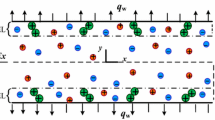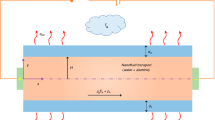Abstract
This paper critically analyzes, for the first time, the effect of nanofluid on thermally fully developed magnetohydrodynamic flows through microchannel, by considering combined effects of externally applied pressure gradient and electroosmosis. The classical boundary condition of uniform wall heat flux is considered, and the effects of viscous dissipation as well as Joule heating have been taken into account. Closed-form analytical expressions for the pertinent velocity and temperature distributions and the Nusselt number variations are obtained, in order to examine the role of nanofluids in influencing the fully developed thermal transport in electroosmotic microflows under the effect of magnetic field. Fundamental considerations are invoked to ascertain the consequences of particle agglomeration on the thermophysical properties of the nanofluid. The present theoretical formalism addresses the details of the interparticle interaction kinetics in tune with the pertinent variations in the effective particulate dimensions, volume fractions of the nanoparticles, as well as the aggregate structure of the particulate system. It is revealed that the inclusion of nanofluid changes the transport characteristics and system irreversibility to a considerable extent and can have significant consequences in the design of electroosmotically actuated microfluidic systems.







Similar content being viewed by others
References
Allain C, Cloitre M, Wafra M (1995) Aggregation and sedimentation in colloidal suspensions. Phys Rev Lett 74:1478–1481
Andreu JS, Camacho J, Faraudo J, Benelmekki M, Rebollo C, Martinez LM (2011) Simple analytical model for the magnetophoretic separation of superparamagnetic dispersions in a uniform magnetic gradient. Phys Rev E 84:021402
Bejan A (2006) Convective heat transfer, 3rd edn. Wiley, India
Buongiorno J (2006) Convective transport in nanofluids. ASME J Heat Transfer 128:240–250
Burgreen D, Nakache FR (1964) Electrokinetic flow in ultrafine capillary slits. J Phys Chem 68:1084–1091
Carstoiu J (1968) Fundamental equations of electromagnetodynamics of fluids: various consequences. Proc Natl Acad Sci USA 59:326–331
Chakraborty S (2006) Analytical solutions of Nusselt number for thermally fully developed flow in microtubes under a combined action of electroosmotic forces and imposed pressure gradients. Int J Heat Mass Transfer 49:810–813
Chakraborty S, Paul D (2006) Microchannel flow control through a combined electromagnetohydrodynamic transport. J Phys D Appl Phys 39:5364–5371
Chakraborty S, Roy S (2008) Thermally developing electroosmotic transport of nanofluids in microchannels. Microfluid Nanofluid 4:501–511
Chakraborty R, Dey R, Chakraborty S (2013) Thermal characteristics of electromagnetohydrodynamic flows in narrow channels with viscous dissipation and Joule heating under constant wall heat flux. Int J Heat Mass Transfer 67:1151–1162
Choi S (1995) Enhancing thermal conductivity of fluids with nanoparticles. FED 231:99–103
Das SK, Putra N, Thiesen P, Roetzel W (2003) Temperature dependence of thermal conductivity enhancement for nanofluids. J Heat Transfer 125:567–574
Das S, Chakraborty S, Mitra SK (2012) Magnetohydrodynamics in narrow fluidic channels in presence of spatially non-uniform magnetic fields: framework for combined magnetohydrodynamic and magnetophoretic particle transport. Microfluid Nanofluid 13:799–807
Dey R, Chakraborty D, Chakraborty S (2011) Analytical solution for thermally fully developed combined electroosmotic and pressure-driven flows in narrow confinements with thick electrical double layers. ASME J Heat Transfer 133:024503
Dey R, Chakraborty D, Chakraborty S (2012) Extended Graetz problem for combined electroosmotic and pressure-driven flows in narrow confinements with thick electric double layers. Int J Heat Mass Transfer 55:4724–4733
Dutta P, Warburton TC, Beskok A (2002) Numerical simulation of mixed electroosmotic/pressure driven flows in complex micro-geometries. J Numer Heat Transfer 41:131–148
Eapen J, Williams WC, Buongiorno J, Hu L, Yip S, Rusconi R, Piazza R (2007) Mean-field versus microconvection effects in nanofluid thermal conduction. Phys Rev Lett 99:095901
Eastman JA, Phillpot SR, Choi SUS, Keblinski P (2004) Thermal transport in nanofluids. Annu Rev Mater Res 34:219–246
Einstein A (1906) Eine neue Bestimmung der Moleküldimensionen. Ann Phys 324:289
Erickson D (2005) Towards numerical prototyping of labs-on-chip: modeling for integrated microfluidic devices. Microfluid Nanofluid 1:301–318
Gad-el-Hak M (1999) The fluid mechanics of microdevices—the Freeman scholar lecture. J Fluids Eng 121:5–33
Ganguly S, Chakraborty S (2009) Effective viscosity of nanoscale colloidal suspensions. J Appl Phys 106:124309
Gregory J (1996) Nanoparticles in Solid and Solutions. In: Fendler JH, Dekany I (eds) Particle aggregation: modeling and measurement. Kluwer, Boston, pp 203–220
Horiuchi K, Dutta P (2004) Joule heating effects in electroosmotically driven microchannels. Int J Heat Mass Transfer 47:3085–3095
Hunter RJ (2001) Foundation of colloid science. Oxford University Press, New York
Ibáñez G, López A, Pantoja J, Moreira J (2014) Combined effects of uniform heat flux boundary conditions and hydrodynamic slip on entropy generation in a microchannel. Int J Heat Mass Transfer 73:201–206
Ilis GG, Mobedi M, Sunden B (2008) Effect of aspect ratio on entropy generation in a rectangular cavity with differentially heated vertical walls. Int Commun Heat Mass Transfer 35:696–703
Jang SP, Choi SUS (2006) Cooling performance of a microchannel heat sink with nanofluids. Appl Therm Eng 26:2457–2463
Jang J, Lee SS (2000) Theoretical and experimental study of MHD (magnetohydrodynamic) micropump. Sens Actuators, A 80:84–89
Jones TB (1995) Electromechanics of particles. Cambridge University Press, New York
Kakac S, Pramuanjaroenkij A (2009) Review of convective heat transfer enhancement with nanofluids. Int J Heat Mass Transfer 52:3187–3196
Kaluri RS, Basak T (2011) Analysis of entropy generation for distributed heating in processing of materials by thermal convection. Int J Heat Mass Transfer 54:2578–2594
Levine S, Marriott JR, Neale G, Epstein N (1975) Theory of electrokinetic flow in fine cylindrical capillaries at high zeta potentials. J Colloid Interface Sci 52:136–149
Li J, Kleinstreuer C (2008) Thermal performance of nanofluid flow in microchannels. Int J Heat Fluid Flow 29:1221–1232
Lim J, Lanni C, Evarts ER, Lanni F, Tilton RD, Majetich SA (2011) Magnetophoresis of nanoparticles. ACS Nano 5:217–226
Magherbi M, Abbasi H, Brahim AB (2003) Entropy generation at the onset of natural convection. Int J Heat Mass Transfer 46:3441–3450
Manz A, Graber N, Widmer HM (1990) Miniaturised total chemical analysis systems: a novel concept for chemical sensing. Sens Actuators, B 1:244–248
Masuda H, Ebata A, Teramae K, Hishinuma N (1993) Alternation of thermal conductivity and viscosity of liquid by dispersing ultra-fine particles (dispersion of Al2O3, SiO2, and TiO2 ultra-fine particles). Netsu Bussei 4:227–233
Maxwell JC (1891) A treatise on electricity and magnetism. Clarendon Press, Oxford
Maynes D, Webb BW (2003a) Fully developed electro-osmotic heat transfer in microchannels. Int J Heat Mass Transfer 46:1359–1369
Maynes D, Webb BW (2003b) Fully developed thermal transport in combined pressure and electro-osmotically driven flow in microchannels. J Heat Transfer 125:889–895
Nguyen NT (2012) Micro-magnetofluidics: interactions between magnetism and fluid flow on the microscale. Microfluid Nanofluid 12:1–16
Pamme N (2006) Magnetism and microfluidics. Lab Chip 6:24–38
Patankar NA, Hu HH (1998) Numerical simulation of electroosmotic flow. Anal Chem 70:1870–1881
Prasher R, Bhattacharya P, Phelan PE (2005) Thermal conductivity of nanoscale colloidal solutions (nanofluids). Phys Rev Lett 94:025901
Prasher R, Phelan PE, Bhattacharya P (2006) Effect of aggregation kinetics on the thermal conductivity of nanoscale colloidal solutions (nanofluid). Nano Lett 6:1529–1534
Probstein RF (1994) Physicochemical hydrodynamics. Willey, New York
Rawool AS, Mitra SK (2006) Numerical simulation of electroosmotic effect in serpentine channels. Microfluid Nanofluid 2:261–269
Reuss FF (1809) Sur un nouvel effet de l’èlectricitè galvanique. Mèmoires de la Sociex Imperiale des Naturalistes de Moscou 2: 327–337
Reyes DR, Iossifidis D, Auroux PA, Manz A (2002) Micro total analysis systems. 1. Introduction, theory, and technology. Anal Chem 74:2623–2636
Sarkar S, Ganguly S, Dalal A (2012) Analysis of entropy generation during mixed convective heat transfer of nanofluids past a square cylinder in vertically upward flow. ASME J Heat Transfer 134:122501-1–122501-8
Sarkar S, Ganguly S, Dalal A (2013) Buoyancy driven flow and heat transfer of nanofluids past a square cylinder in vertically upward flow. Int J Heat Mass Transfer 59:433–450
Sarkar S, Ganguly S, Biswas G (2014a) Buoyancy driven convection of nanofluids in an infinitely long channel under the effect of a magnetic field. Int J Heat Mass Transfer 71:328–340
Sarkar S, Ganguly S, Dalal A (2014b) Analysis of entropy generation during mixed convective heat transfer of nanofluids past a rotating circular cylinder. ASME J Heat Transfer 136:062501-1–06250110
Soong CY, Wang SH (2003) Theoretical analysis of electrokinetic flow and heat transfer in a microchannel under asymmetric boundary conditions. J Colloid Interface Sci 265:202–213
Wang XW, Choi SUS, Xu XF (1999) Thermal conductivity of nanoparticle-fluid mixture. J Thermophys Heat Transfer 13:474–480
Wasan DT, Nikolov AD (2003) Spreading of nanofluids on solids. Nature 423:156–159
Xuan Y, Li Q, Zhang X, Fujii M (2006) Stochastic thermal transport of nanoparticle suspensions. J Appl Phys 100:043507
Yang C, Li D, Masliyah JH (1998) Modeling forced liquid convection in rectangular microchannels with electrokinetic effects. Int J Heat Mass Transf 41:4229–4249
Yang RJ, Fu LM, Lin YC (2001) Electroosmotic flow in microchannels. J Colloid Interface Sci 239:98–105
Yu W, Choi SUS (2004) The role of interfacial layers in the enhanced thermal conductivity of nanofluids: a renovated Hamilton–Crosser model. J Nanopart Res 6:355–361
Zade AQ, Manzari MT, Hannani SK (2007) An analytical solution for thermally fully developed combined pressure-electroosmotically driven flow in microchannels. Int J Heat Mass Transfer 50:1087–1109
Zeng S, Chen CH, Mikkelsen JC, Santiago JG (2001) Fabrication and characterization of electro-osmotic micro-pumps. Sens Actuators, B 79:107–114
Author information
Authors and Affiliations
Corresponding author
Rights and permissions
About this article
Cite this article
Sarkar, S., Ganguly, S. Fully developed thermal transport in combined pressure and electroosmotically driven flow of nanofluid in a microchannel under the effect of a magnetic field. Microfluid Nanofluid 18, 623–636 (2015). https://doi.org/10.1007/s10404-014-1461-4
Received:
Accepted:
Published:
Issue Date:
DOI: https://doi.org/10.1007/s10404-014-1461-4




